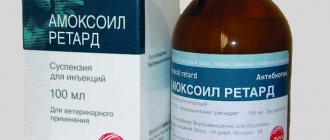What is metronidazole?
Metronidazole is used primarily as an antidiarrheal medication for cats.
It is effective against several protozoal infections, including Giardia, Trichomonas and Balantidium coli parasites, as well as anaerobic bacterial pathogens. Metronidazole may also be prescribed to relieve inflammation of the intestinal tract. Because the drug can cross the blood-brain barrier and bone, it is sometimes used to treat infections of the central nervous system, bones, and teeth.
III. Application procedure
11. Metronide 50 is prescribed to pigs for dysentery caused by Treponema (Serpulina) hyodysenteriae and anaerobic bacteria, as well as for balantidiasis caused by Balantidium suis.
12. A contraindication to the use of the drug Metronide 50 is increased individual sensitivity to metronidazole and other components of the drug. It is not recommended to prescribe the drug in case of severe liver and kidney dysfunction.
13. Metronide 50 is used intramuscularly in doses: for dysentery 1 ml/10 kg of animal weight (metronidazole 5 mg/kg) and for balantidiasis 2 ml/10 kg of animal weight (metronidazole 10 mg/kg), twice with an interval of 48 hours.
If the volume of the injected solution exceeds 10 ml, it should be administered to the animal in several places.
In severe cases (especially with anaerobic infections), it is administered daily once a day for 3-5 days.
If necessary, the course of treatment is repeated after 10-15 days. At the same time, symptomatic treatment is carried out, vitamins are prescribed, and areas where animals are kept are disinfected and deratized.
Calculate dosage
14. In case of an overdose of Metronide 50, the following symptoms are observed: nausea, vomiting, ataxia, and in severe cases, peripheral neuropathy and epileptic seizures. Treatment for overdose is symptomatic; there is no specific antidote.
15. No specific effects were identified during the first use of the drug and upon its discontinuation.
16. The drug Metronid 50 is prohibited from being used in the first third of pregnancy; in young animals, lactating and deeply pregnant sows, the drug is used with caution, under the supervision of a veterinarian.
17. If one or more doses of the drug are missed, use should be resumed as soon as possible in the prescribed dosage and regimen. Do not administer a double dose to compensate for a missed dose.
18. When using the drug in accordance with the instructions, side effects and complications, as a rule, are not observed. In some animals, a local reaction in the form of itching, erythema, and swelling may occur at the site of drug administration, which spontaneously disappear without the use of therapeutic agents. Allergic phenomena are possible in some animals, in the event of which the use of the drug is stopped and desensitizing therapy is carried out.
19. The drug Metronide 50 cannot be used simultaneously with alcohol-containing drugs. Metronidazole enhances the effect of indirect anticoagulants.
20. Slaughter of pigs for meat is permitted no earlier than 15 days after the last administration of the drug. The meat of animals forcedly killed before the expiration of the specified period is used to feed carnivores.
Metronidazole dosage for cats
Metronidazole dosage varies in cats
depending on its intended use and the specific treatment of the patient. The dose range for oral metronidazole in cats is 7.5 to 25 mg/kg. Higher doses may be given once daily, while lower doses are usually given twice daily. Always follow the dosing instructions provided in your pet's medication prescription and contact your veterinarian with any questions or concerns.
For giardiasis in cats, metronidazole is given to cats at 17 mg/kg every 24 hours for 8 days (1/3 t per cat). Immunomodulatory doses of metronidazole for cats 5-7.5 mg/kg 1-2 times a day for 6-8 weeks (orally or parenterally).
Metronidazole for cats, instructions for use: indications and dosage for kittens and adult cats
Treating cats usually requires special medications designed for animals.
They are produced taking into account the metabolic characteristics of representatives of the cat family, which allows you to extract maximum benefit from the medicinal substance and avoid unwanted effects.
However, there are a number of products that are suitable for both people and cats. They are sold in regular pharmacies without a prescription.
One of these drugs is Metronidazole and its analogues based on the active substance of the same name (for example, Trichopolum). What diseases in cats can be treated with metronidazole? How to correctly calculate the required dose? What is the most convenient method of administration?
Chemical composition of the drug
The active substance of the drug is a synthetic derivative of azomycin, which in nature is produced by a special genus of bacteria - streptomycetes. Metronidazole demonstrates the greatest activity against anaerobic bacteria and protozoa (amoebas, histomonads, trichomonas, etc.).
There are 5 forms of the drug on sale:
- tablets of a white or yellowish-greenish tint, which may contain 25% or 50% of the active substance with a weight of 250 mg, 500 mg or 1000 mg; white or yellowish powder in bags of varying weights;
- injection solution containing 5 g of metronidazole per 100 ml;
- suppositories (suppositories) with 0.1 g of active substance;
- gel for external use 1%.
What medicines contain metronidazole: list, cost, use
Metronidazole is available in several forms:
- tablets of 500 and 250 mg (a package containing 20 tablets costs from 15 to 100 rubles);
- suspension containing 200 mg/5 ml (price per 100 ml bottle - from 200 rubles);
- sterile solution for intravenous injection 5 mg/ml (100 ml bottle costs 27 rubles);
- 1 percent gel and ointment for external use (30 g - from 190 rubles);
- dental gel 1 percent (price of a tube of 20 g - 258 rubles).
Other release options (vaginal cream and suppositories) are usually not used in veterinary medicine. Oral and parenteral forms are prescribed according to indications.
Metronidazole should not be used to treat pregnant or nursing cats. If it is necessary to give the drug to a nursing cat, then the kittens are transferred to artificial feeding until the end of treatment.
For kittens under 6 months of age, the medicine is prescribed only in extreme cases.
The principle of action of the drug
Metronidazole affects the DNA of microorganisms and protozoa, suppressing the production of nucleic acids and causing their death. Once inside the animal’s body, the substance is well absorbed from the gastrointestinal tract and distributed throughout the body’s biological fluids (saliva, bile, cerebrospinal fluid, etc.).
The active substance accumulates in the liver and is excreted after 1-2 days along with waste products.
Side effects
The use of Metronidazole for cats, like any other antimicrobial drug, significantly affects the animal’s immunity, weakening the body’s protective functions.
That is why during treatment with the drug it is recommended to isolate the pet from other animals and keep the house completely clean for a certain time.
Against the background of a weakened immune system, the pet may develop signs of an allergy that was not previously noticed, which will lead to a deterioration in the animal’s condition.
In addition, the cat may experience nausea, vomiting, diarrhea, constipation, loss of appetite and other gastrointestinal disorders.
Hyperactivity, weakness, frequent urination, drowsiness, dizziness and depression are also observed in animals. As a rule, you can notice such negative reactions at the first manifestations, since the cat’s body is very sensitive.
An extremely rare increase in body temperature is also a side effect of taking the drug. During illness, it is difficult to determine the connection between fever and the prescribed drug on your own, so you need to carefully monitor any changes in your pet’s behavior.
Elimination of all minor reactions is carried out by stopping the medication, but, as a rule, this is not required, since in most cases the correct dosage does not entail any negative consequences.
Application and dosage of the drug
For cats of any age, Metronidazole is prescribed for diagnosed diseases such as:
- giardiasis and histomoniasis;
- dysentery, diarrhea (with severe diarrhea);
- anaerobic postoperative infections, including after obstetric procedures;
- ulcerative gingevitis;
- trichomoniasis and balantiosis;
- necrotizing mastitis and necrobacteriosis.
The required amount of medicine is calculated based on the weight of the animal, according to the proportion - 10 mg of the active substance per 1 kg. However, the attending physician can change this treatment regimen based on specific symptoms and the general condition of the patient.
We recommend reading about the use of the antibiotic “Clamoxil” for the comprehensive fight against infections in pets.
Source: https://murashdom.ru/lekarstva/ronidazol-dlya-koshek.html
As a rule, different specialized drugs are used to treat people and animals, but some medications can be considered universal. One of these drugs is the antibiotic Metronidazole, originally intended for the treatment of humans, but today it is widely used in veterinary medicine.
It is prohibited to use it independently on animals, and only an experienced specialist can prescribe the drug, taking into account the diagnosis and weight of the pet to calculate the correct dosage.
Purpose
Treatment of cats and dogs with Metronidazole is carried out if the animal has certain skin diseases, parasites or oral infections.
Cats are especially sensitive to side effects, so when choosing a medication you should take this into account and regularly monitor your pet's health.
Animals who are pregnant, lactating or have liver failure should not take this drug.
In veterinary pharmacies, Metronidazole for cats can only be purchased with a doctor's prescription. The drug is sold in the form of tablets and injection solutions.
The features of the latter option should not even be considered, since only a veterinarian can use it in treatment.
In tablet form, the medication is prescribed for home treatment, and you can learn more about treating pets with them from the material provided.
Metronidazole tablets for cats can be purchased from any manufacturer. Changing the pharmaceutical company does not in any way affect the effectiveness of the drug. The medication is available in dosages of 250 or 500 mg. The tablets are always white, flat-cylindrical, round in shape, with a bitter taste.
Metronidazole is classified as a broad-spectrum antimicrobial and antiprotozoal agent. It can be used in the complex treatment of mastitis, gingivitis, postpartum infections, gastrointestinal diseases, dysentery, stomatitis, diarrhea, balantidiasis, necrobacteriosis, giardiasis, infection with amoebas, trichomonas, and so on.
“Metronidazole” for cats, dogs and other domestic animals (even cattle) is an excellent remedy for many diseases; moreover, they become infected with parasites much more often than humans themselves.
How to give the drug
Cats are very sensitive to any changes in taste, so they rarely eat food with added medication. The bitter taste of the tablet repels the animal, and treatment requires choosing a different tactic.
As such, there are no instructions for the use of Metronidazole for cats, since the drug is intended for human therapy. You can find out all the details of dosage and administration from your veterinarian.
Experts advise washing your hands thoroughly before starting to work with the medication. After this, the required amount of the drug must be crushed into powder and diluted with a small amount of water so that the liquid fits into a syringe without a needle.
The animal must be immobilized by wrapping it tightly in cloth, open the cat’s mouth with your fingers and pour the contents of the syringe directly into the throat. This is the only way the pet will not be able to spit out the drug and injure the owner.
Dosage
On average, the active component of the drug is 10 mg per 1 kg of cat weight. The dosage of Metronidazole for each specific case is calculated individually depending on the severity of the disease and the exact weight of the pet. For some individuals, for a complete and rapid recovery, it is enough to give only 8 mg/kg.
The frequency of administration is always 2 times a day with an interval of 12 hours. It is recommended to choose morning and evening times for this. Relief from the condition of a sick pet occurs after the first dose, since the concentration of the active substance remains at 80% for 8 hours after administration.
Prohibitions on use
Metronidazole is contraindicated for cats during lactation, since the active ingredient of the drug enters the milk, making it bitter and affecting the health of the kittens.
If such treatment is necessary, feeding is interrupted and the kittens are transferred to artificial formula. In the future, the litter rarely returns to breastfeeding, so the owner should prepare for the fact that he will have to feed the kittens on his own. You cannot treat an animal during pregnancy, since the substance can harm future babies.
Contraindications are also the pet's liver failure and a tendency to allergies. Cats are generally very sensitive to many external and internal irritants, so the drug should be prescribed taking into account all the characteristics of the animal’s body and possible reactions when several medications interact.
Recommendations from experts
To avoid serious health problems for your pet, you should regularly prevent parasite infestation. Cats, especially those that go outside, are prone to developing enterobiasis, head lice, fleas and other pests.
Metronidazole may not always help cats, so at the first symptoms of infection, you should contact a veterinarian for appropriate help.
If your pet has diarrhea and is unable to visit a doctor, you can give the drug to your pet yourself, but only after correctly calculating the dose. Even if the symptoms stop after this, you still need to seek advice from a specialist.
Metronidazole can be stored at temperatures from -10 to +40 without loss of therapeutic properties, the main thing is not to leave the medication in open sunlight and with free access to children. You can purchase the drug at any pharmacy at an average cost of 25 rubles.
Analogs
If necessary, antibiotics can be replaced by drugs with a wider spectrum of action:
- "Levomycetin";
- "Ofloxacin";
- "Doxycycline" and others.
Along with the therapeutic effect, the list of contraindications, side effects and the risk of their occurrence increases, so if the doctor recommends using Metronidazole, you should not replace the drug yourself or ask a specialist about it.
Reviews
Veterinarians have long been using in their practice not only specialized drugs for animals, but also medicines from regular pharmacies. As for the treatment of dogs, it is much easier to find a suitable drug, but when treating giardiasis in cats, veterinarians trust only Metronidazole. It so happens that nothing more effective has yet been invented.
As for the treatment of animals that have contraindications for health reasons, despite all the advantages of the medication in question, replacing it is simply necessary for the health and life of the animal. The instructions for Metronidazole (the dosage is prescribed for cats by a veterinarian) provide for treatment at any stage of parasite infection and guarantee results.
Veterinarians speak extremely positively about the drug, since it demonstrates the best performance indicators and, with the correct dosage, is in most cases well tolerated by pets.
Experts assure that in order to consolidate the results of treatment, it is necessary not only to complete the entire course, but also to provide the pet with adequate nutrition in the future, which will be enough for prevention.
Owners of cats say that in rare cases, the animal’s body may react negatively to the medication.
Source: https://FB.ru/article/432420/metronidazol-dlya-koshek-naznachenie-dozirovka-instruktsiya-po-priemu-i-otzyivyi-veterinarov
Side effects of metronidazole
Because Metronidazole crosses the blood-brain barrier, neurological side effects are possible with this drug. This usually occurs when pets are given larger doses than recommended or when they are on long-term therapy, especially if they are malnourished or suffering from liver dysfunction. Signs of neurological side effects for metronidazole include:
- Depression and confusion
- Unstability while standing or walking
- Unusual eye movements
- Head tilt
- Ataxia
- Seizures
- Immobility
Other possible side effects of metronidazole in cats include:
- Allergic reaction (difficulty breathing, hives, etc.)
- Drooling and vomiting (the drug is very bitter)
- Vomit
- Loss of appetite
- Diarrhea
- Lethargy
- Blood in the urine or dark urine
- Liver damage
Medicines that react with metronidazole:
Metronidazole for cats: instructions for use
First of all, all pet owners need to know that when choosing self-medication or going to the veterinarian when the animal starts to get sick, preference should be given to specialists.
Only an experienced veterinarian is able to give correct recommendations to questions that arise, establish a diagnosis and prescribe effective treatment. Sometimes the disease is serious and self-medication can only complicate the situation.
Veterinarians prescribe metronidazole when identifying the following ailments in an animal:
- Diarrhea;
- Mastitis;
- Balanthiosis;
- Necrobacteriosis;
- Postpartum infections;
- Dysentery;
- Gingivitis;
- Stomatitis.
Metronidazole in ointment form is used for various skin diseases.
What is the effect of metronidazole?
Metronidazole is an antiprotozoal and antimicrobial agent with broad action.
Capable of destroying the following bacteria:
- Amoeba;
- Trichomonas;
- Giardia.
The drug was originally produced for the treatment of people, but experiments and tests determined that the drug works well for animals: horses, dogs, cats. Parasites are more common in animals than in people. Many veterinarians believe that Metronidazole can cure various infections. After only 7-8 hours, 80 percent of the product is retained in the animal’s body.
People are also treated with metronidazole, for more details see our article: The best and most effective medicines against worms and parasites
What is the dosage of metronidazole?
Only an experienced veterinarian can determine what dose of the drug should be given to the animal. You cannot make such decisions yourself, measure grams and calculate proportions.
The optimal dosage is considered to be:
- For 1 kg of animal weight, 10 mg of the drug is prescribed;
- Given twice a day.
Is metronidazole harmful for cats?
When used in a timely manner and in the correct dosage, the product rarely causes harm to cats. But it happens that the animal has other, unspecified diseases, and the use of Metronidazole complicates its general condition.
The drug has a negative effect on the immune system, after treatment they need:
- Protect the animal from various infections;
- Follow home regime or quarantine.
Veterinarian recommendations
The body of animals, including cats, is very susceptible to a variety of parasites. For this reason, regular preventive measures against worms are required.
In the event that at a certain stage of treatment with Metronidazole there are suspicions of the presence of enterobiasis, it is necessary to simultaneously treat for parasites, change the way of life and diet.
The fact is that while walking along the street, a cat can become infected with many diseases, and it must be removed from others for a while and kept absolutely clean.
We also recommend that you read our other article: Worms in cats: symptoms, causes and treatment methods
Metronidazole for diarrhea in cats
Cats often suffer from diarrhea, especially at an early age. Frail body systems do not function at full capacity, so any, even minor changes in nutrition can lead to problems with the gastrointestinal tract.
In situations where the cat’s health becomes critical and it is not possible to get to a veterinary clinic or call a doctor at home, you can proceed as follows:
- Crush Metronidazole tablets in the required quantity;
- Dilute the drug with water, put it in a syringe and pour it into the cat’s mouth; you can also mix the medicine with food and see that the animal eats it.
Intravenous treatment with Metronidazole is also possible. As a rule, this is done in difficult situations and in medical institutions. The duration of this treatment is three days. Then you can switch to tablets. If the pet recovers within three days, it is advisable to stop giving it the medicine.
Contraindications
Despite the popularity and widespread use of this drug, there are certain contraindications for its use in animals:
- Having a cat with allergies is a serious reason to refuse medication. Naturally, it is advisable to discuss this issue with a veterinarian. If the situation worsens, the use of corticosteroids may be necessary. Such parallel treatment may worsen the animal’s condition.
- Liver failure.
- During lactation, most of the components end up in the cat's milk, which loses its taste, becoming bitter, and also negatively affects the health of the kittens. They may develop gastrointestinal diseases and allergies. Deaths are quite rare. It is necessary to isolate kittens in a timely manner and implement artificial nutrition. Only on the third day after taking Metronidazole can you resume breastfeeding; in general, this is quite difficult to do and the kittens will have to be fed independently until they learn to eat on their own.
- Taking Metronidazole during pregnancy affects the condition of the cat, as well as unborn kittens. At present, the effect of the drug during pregnancy has not been fully studied, but there have been cases where the cat’s health deteriorated significantly.
Side effects
Metronidazole may cause the following side effects:
- Changes in the nervous system . Hyperactivity or depression, weakness, dizziness, drowsiness. As a rule, side effects are clearly noticeable in cats. This allows you to react in a timely manner and show your pet to the doctor.
- With treatment, fever does not seem to be a side effect. This is true, so it is not possible to independently determine this connection.
- Problems with the gastrointestinal tract . The following symptoms may occur: vomiting, constipation, deterioration or loss of appetite, nausea, diarrhea. In such situations, it is advisable to consult a doctor who will determine the need to continue or discontinue treatment with this medicine.
- problems with urination during treatment , it is recommended to stop treatment and wait for the doctor’s recommendations.
- In the case where no allergy was previously detected in the cat, then during treatment the immunity becomes weaker so that even an ordinary allergy can greatly harm the cat’s body. For this reason, if you experience nasal congestion, itching or rash, it is recommended to consult a doctor. In some situations, stopping treatment with metronidazole may be sufficient. It should be noted that such cases are rare; animals tolerate the medicine normally.
Metronidazole price
The cost of the drug, regardless of the form of release (infusion solutions, suppositories, tablets), is almost the same.
Eg:
- 10 suppositories of 500 mg cost about 56 rubles;
- 20 tablets of 250 mg – approximately 25 rubles;
- 100 mg infusions containing the same amount of active ingredient cost from 25 rubles.
Analogs
In the absence of metronidazole, broad-spectrum antibiotics can be used:
- Ofloxacin;
- Doxycycline;
- Levomecitin.
One of the most important storage conditions is to avoid exposure to UV rays, because the medicine begins to decompose under the influence of the sun, its qualities are lost, and it becomes dangerous. The optimal temperature for storage is no more than 20 degrees.
The medicine is yellow. When excreted from the body, urine takes on an orange tint. Tablets with a bitter, unpleasant taste. Therefore, it is necessary to give the animal the medicine so that it cannot taste it. It is recommended to have an assistant for such an operation, because cats can show aggression and scratch strongly.
Use our advice wisely, and let your furry pet always be healthy!
Source: https://bolezney.net/metronidazol-dlya-koshek/
Drug interactions
- Cimitidine
- Cyclosporine
- Warfarin
- 5-fluorouracil
- Phenytoin
- Phenobarbital
There are several drugs available to treat giardiasis in cats, including metronidazole.
The purpose of this study was to determine whether metronidazole benzoate, administered at a dose of 25 mg/kg, orally, twice daily for 7 days, reduces or eliminates shedding of Giardia cits in cats with chronic infection. Twenty-six adult, laboratory-reared cats were used in this study. Sixteen cats were orally infected with cysts of the human giardiasis pathogen Giardia sp. The remaining ten cats were infected with the same Giardia sp. presumably due to contamination from an adjacent room where cats were studying the Giardia vaccine. A fecal sample was collected from each cat within 1 week of initiation of treatment and then every 2 to 4 days for 15 days after completion of treatment. Fecal samples were analyzed for the presence of Giardia cysts using a commercially available direct immunofluorescence (IFA) test. No clinical signs of drug toxicity were detected during the study.
Always rule out intestinal parasites for gastrointestinal diseases in cats. Treatment of giardiasis with oral administration of metronidazole.
Parasites should always be considered in any patient with chronic GI signs. Veterinarians often prescribe empirical anthelmintics such as fenbendazole or pyrantel. Giardia is usually diagnosed using proper stool examination techniques. In cats, Giardia lives in the lower small intestine (dogs in the upper intestine), and signs can often be associated with colitis-like signs in the large intestine. The treatment of choice for many years has been metronidazole. Metronidazole 15–25 mg/kg orally once or twice daily for seven days is currently recommended. Neurologic signs with metronidazole toxicity occur at higher doses (>30 mg/kg/day), so proper dosing is critical.
^Top
Instructions for use
Metronidazole should be used to treat a cat strictly according to the indications and instructions of the veterinarian. When working with the injectable form of the medication, you will need to follow safety and personal hygiene rules. Therefore, every time before administering an antibiotic to a kitten and after the procedure, you must wash your hands with soap. Experienced doctors recommend avoiding contact of the medicine with the skin and mucous membranes, otherwise you will need to immediately rinse the affected areas with plenty of water.
Metronidazole is administered intravenously if the kitten is in serious condition and the disease is at its peak of development.
The tablet form of the drug is prescribed to the animal after three days of injections.
After the injections, the pet is transferred to a tablet form of the antibiotic within 72 hours. The dosage is selected individually for each cat, as it depends on the diagnosis and the weight of the cat. So, the dose is calculated: for each kg of purring body weight - 10 mg AB. At this dosage, 2 manipulations are carried out per day, but for some diagnoses it is possible to increase the frequency of use of the medicine up to 4 times a day. Cats do not always agree to take pills, then the owners need to use a trick and crush the pill into powder, then dilute it with water and pour it into the mouth with a syringe or mix it with food.
What is the effect of metronidazole?
Metronidazole is an antiprotozoal and antimicrobial agent with broad action.
Capable of destroying the following bacteria:
The drug was originally produced for the treatment of people, but experiments and tests determined that the drug works well for animals: horses, dogs, cats. Parasites are more common in animals than in people. Many veterinarians believe that Metronidazole can cure various infections. After only 7-8 hours, 80 percent of the product is retained in the animal’s body.











